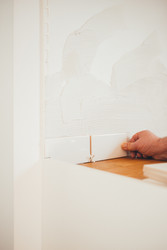5 Silicone Sealant Facts to Know Before Your Next Project
Feb 27th 2023
If you’re often working on construction or DIY projects, you’re probably already familiar with silicone sealant. This adhesive is flexible and durable and can withstand the elements, whether it’s a torrent of rain showers, grueling heat, or bitter cold. Silicone sealant fills gaps, cracks, and holes with air and water-tight seal. There’s a lot to know about this handy product, and we’ve compiled a list of 5 more facts about silicone sealant in this article. Read on to learn some useful facts about this incredible product!
Variety of Applications
Because of its chemical-resistant and water-repellent properties, silicone sealant is useful in many different industries. Of course, silicone sealant is commonly used around the home to seal gaps around windows, doors, sinks, bathtubs, and other areas. However, you might not know that silicone sealant is also used in many construction jobs to bind surfaces like glass, plastic, and metal together. It’s even used on aquariums and on some kitchen appliances! Some silicone sealants make for great gasket-makers and can fix leaky cars in a pinch. Silicone sealant also lasts much longer than other adhesives, making it a great long-term fix for any project.
Curing Process
When reading online about silicone sealant, you’ll quickly come across the word “cure.” Many people confuse curing with drying, but they’re two different things. Drying refers to the process in which moisture and water evaporate, but curing refers to the chemical changes that occur when the sealant is exposed to oxygen. Silicone sealant is usually dry to the touch after 30 minutes, but the curing process will take much longer. Generally, it takes about 24 hours for silicone sealant to cure completely.
There are two factors that affect how fast silicone sealant cures: humidity and temperature. Warmer temperatures and more humidity will make the curing process faster. Ideal temperatures for curing are between 40°F and 100°F. The adhesive can cure with as little as 5% humidity and up to 95%.
Silicone Sealant Application
The best way to apply silicone sealant is to use a caulking gun. Here’s how it’s done:
- Pull back the loading pin, then insert the base of the silicone tube into the back part of the gun. Push the pin in again to lock the tube into the gun.
- Wherever you apply the sealant, make sure it’s been cleaned with a sponge, soap, and water. Dry down the area thoroughly after cleaning. Having a clean surface to work from will make for a better seal.
- Cut the end of a tube with a knife at a 45-degree angle. This will allow for precise control over the flow of sealant from the tube.
- Pressing on the trigger, apply the sealant as slowly and evenly as possible. Keep a bucket of water nearby, so you can wet your finger and smooth out the sealant as you go.
Types of Silicone Sealant
Not all silicone sealants are the same! You can find them in two main categories; neutral cure and acid/acetoxy variants. Acetoxy silicone sealants work best on non-porous surfaces such as tile and glass, while the former is better for projects involving wood, plastics, or more scratchable metals.
You can also categorize sealants by whether they are high modulus or low modulus. High-modulus sealants cure faster but emit a potent, vinegar-like smell. Acetoxy sealants are mostly in this category. Neutral cure sealantsare low-modulus, so they take longer to cure, emit less of an odor, and result in a more flexible seal.
You can also find different kinds of silicone sealants depending on the project you’re working on. For car repairs, try automotive silicone sealant. If you’re working on a bathroom or kitchen, look for mildew or mold-resistant adhesive.
Color Options
Most silicone sealants cannot be painted over. However, there are a variety of colors to make the finished product more aesthetically pleasing after you’ve finished applying the seal. You can find bright colors like blue, red, and gold, but there are also many more neutral options that will blend in with the surrounding space. If you want the most discreet seal, you can also opt for a clear coat instead of a colored one.
Silicone Sealant: An Essential Tool for Your Next Project
Now that you’ve learned a little bit more about the basics of silicone sealant, you hopefully have a clear idea of how versatile and useful this product can be! Whether your next project is some sort of home repair, a commercial project, or even a craft project, silicone sealant is a great product to have in your DIY arsenal! Shop Silicone Depot today to shop the best silicone sealant products online.

